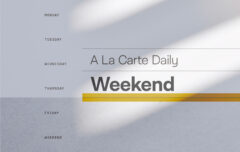“I do not ask for these only, but also for those who will believe in me through their word, that they may all be one, just as you, Father, are in me, and I in you, that they also may be in us, so that the world may believe that you have sent me” (John 17:20-21).
Jesus’ High Priestly prayer, clearly shows the emphasis Jesus places on unity within the church. His desire is that the church show forth the same unity expressed in the relationship between the members of the Trinity – a unity that is perfect and beautiful to behold. This prayer has two dimensions to it: a future fulfillment where the unity among believers will be as perfect as that displayed among the members of the Trinity, and a present fulfillment where believers enjoy unity, albiet imperfect unity, with one another. To be faithful to our Lord we must work towards that present unity while looking forward to the final unity, that the body of Christ may not be fractured.
An important consideration, though, is the cost of unity. In Ephesians 4:5 we read of “one Lord, one faith, one baptism.” This forms a framework for unity. We cannot have unity with people or groups who deny the absolute essentials of the faith. We must have unity on the foundation of the essentials of the faith, not despite the essentials. In the sixteenth century Protestantism emerged from the Roman Catholic Church. Protestants had tried and failed to bring change to the Roman Church and had seen the necessity of breaking fellowship. The early Reformers did so only with heavy hearts, for they desired unity in the body. Yet they saw that the Catholic Church denied the essentials of the faith. The Reformation has since been viewed by some as a necessary evil, by others as the re-emergence of the true, biblical church, and by still others a terrible tragedy that split the church asunder.
Today, five centuries later, many of the differences between Protestants and Catholics seem to be rapidly disappearing. Protestants and Catholics alike are beginning to ask, “Is the Reformation Over?” Among those asking this question are Mark Noll, Professor of Christian Thought at Wheaton College, and Carolyn Nystrom, who is a freelance writer and journalist. They subtitle their book, Is The Reformation Over?, “An Evangelical Assessment of Contemporary Roman Catholicism.” They are clear on their purposes for this book, which is formal and scholarly in tone. First, “it is intended as an evangelical assessment of contemporary Roman Catholicism, with special attention given to the dramatic changes that have taken place since the Second Vatican Council. It deals primarily with conditions in the United States but not to the exclusion of evidence from Canada, Latin America, Europe, and elsewhere in the world…we do not propose a final, universal, or dogmatic assessment of Roman Catholicism” (page 13). Second, they “to provide evangelical interpretations, grounded in both classical Christian theology and the broad history of Christianity, of what we see in the contemporary Catholic Church” (page 14).
Overview
I will begin this review by providing an overview of each of the nine chapters.
The first chapter, entitled “Things Are Not The Way They Used To Be,” surveys the changes in Catholic-Protestant relations over the past few decades. They detail a variety of Protestant leaders who have been instrumental in forging closer ties with Rome. Among these are Billy Graham and Nicky Gumbel (of Alpha Course fame). While the emphasis in this chapter (and indeed, throughout the book) is on Evangelicals who have extended a hand towards Catholicism, there are a few examples of Catholics who have worked to forge closer ties with Protestants.
Chapter two, “Historic Standoff,” provides a brief history of the relationship between Catholics and Protestants since the time of the Reformation. The authors detail some of the anti-Catholic thought that dominated American politics and religion for many years.
The third chapter, “Why Did Things Change?,” attempts to answer the question of why the situation has changed so rapidly over the past few decades. Why have so many Protestants reversed their position on Catholicism? They cite several reasons: changes in the Catholic Church, changes in world Christianity, changes in American politics and society, changes in the exercise of personal agency, and changes within Evangelicalism. As we might expect, the authors place great emphasis on the Second Vatican Council as the main instrument of change, agreeing with David Wells that “the council opened Catholicism to greater influence from Scripture and more concentration on Christ-centered faith” (page 60).
In the fourth chapter, “Ecumenical Dialogues,” the authors provide summaries and assessments of some of the most notable ecumenical dialogues since the 1960’s. Among those who have dialogued with the Roman Catholic Church are Anglicans, Methodists, Pentecostals, the Disciples of Christ, Reformed, Lutherans, and Baptists. The primary discovery in all these discussions, say Noll and Nystrom, is that “the most serious differences were rooted in ecclesiology, contrasting versions of what the church is and how it functions” (page 113). While they groups were able to agree in many areas, only the Anglicans would begin to bend on the issue of ecclesiastic authority. “No other Protestant body would accept the infallibility of the pope, even after Catholics carefully qualified that papal infallibility is limited to when the pope speaks ex cathedra” (page 113). At the close of the chapter they ask, “On the basis of ecumenical dialogues, can it be said that the Reformation is over? Probably not. But a once-yawning chasm has certainly narrowed” (page 114). And, indeed, this must be the case if, as the authors suggest, it is true that mere ecclesiology forms that chasm.
Chapter five, “The Catholic Catechism,” examines the Catholic Catechism, about which the authors correctly note, “If you are a Catholic, this is your doctrinal statement – whether or not you are fully aware of its contents. This point bears repeating. It is one thing to conclude that many Catholics do not live up to their church’s official teaching or to argue that the Catholic hierarchy tolerates too much latitude in promoting official Catholic beliefs. It is an entirely different thing to make mistakes concerning the church’s official standard of doctrine. The Catechism, as it was published in the mid-1990’s, is the official teaching of the Roman Catholic Church” (page 116). The authors go on to say that “Evangelicals or confessional Protestants who pick up the Catechism are in for a treat. Sentences, paragraphs, whole pages sound as if they come from evangelical pulpits…” (page 116). The chapter goes on to show many of the areas of agreement, where the Catechism can be easily reconciled with Protestant theology. Among them, according to the authors, are common orthodoxy, common devotion to God, and a common understanding of holy living. There is also an examination of the differences, which include questions of authority, Mary’s role in the life of believers, baptism, salvation by works or grace, celibacy and saints, and sacraments and worship. In general the authors do not simply list the differences, but also attempt to minimize them. For example, when discussing salvation, they indicate, “If…both groups can agree (as they appear to) that salvation is by grace through faith in Jesus Christ, evangelicals and Catholics can welcome each other as brothers and sisters of the family created by God’s grace, regardless of whatever else either may want to say” (page 142). They conclude that “The Catechism proclaims a deeply Christian faith, and is does so with grace” (page 150). The chapter closes with a non-answer to the question posed by the book’s title. “Is the Reformation over? Maybe a better question we evangelicals should ask ourselves is, Why do we not possess such a thorough, clear, and God-centered account of our faith as the Catechism offers to Roman Catholics” (page 150)?
The sixth chapter, “Evangelicals and Catholics Together,” examines the content and the impact of the ECT dialogues and documents, begun by Charles Colson and Richard John Neuhaus. Each of the four ECT documents is examined and some attention is paid to the evangelicals who reacted strongly in opposition to them, including men like John MacArthur, James Boice and Michael Horton. In a discussion of the ramifications of the ECT dialogues the authors correctly understand that at the heart of disagreement is the issue of justification. But, taking their cue from J.I. Packer, they write, “Debate on the exact definition of justification may not be as important as it seems” (page 180). They quote Packer’s assertion that Catholics and Protestants have sufficient agreements on the nature of the gospel that they can and should engage in shared evangelistic ministry. Noll and Nystrom also suggest that “the Roman Catholic Church now [post-Vatican II] articulates positions on salvation – even on justification by faith – that are closer to the main teachings of the sixteenth-century Protestant Reformation than are the beliefs of many Protestants, indeed, of many evangelical Protestants. Strange as it may seem to put it this way, the ECT documents present what can only be called a classically orthodox depiction of Christian salvation, primarily because they empahsize and build upon these official Catholic teachings” (page 180). The chapter concludes with the authors stating their conviction that ECT is a work of the Holy Spirit and one that began far before ECT and will continue long after.
Chapter seven, titled “Reactions From Antagonism to Conversion,” describe some of the strong reactions to Catholicism. They discuss the writings, among others, of Jack Chick, Donald Barnhouse, John MacArthur and R.C. Sproul. They go on to detail the stories of several evangelicals, such as Peter Kreeft, Dennis Martin and Thomas Howard, who converted from Protestantism to Catholicism, showing what each of these people gained and lost through their conversion. Notable by their absence are corresponding stories of conversion away from Rome.
The eighth chapter represents the low-point of the book and could (and perhaps should) have been omitted by a discerning editor. “This chapter represents an exercise in prudential reasoning. It is an effort to sort out the current situation by analyzing the position of evangelicals and Catholics with respect to main themes in American history” (page 209). They discuss political antagonism and the sex scandals of recent years, but do so in a terse and unsatisfying manner.
The final chapter returns to the central theme of the book, asking once more, “Is the Reformation Over?” The authors divide the chapter into several unequal sections. “Questions of Belief” turns again to the beliefs the authors feel are shared between Protestant and Catholic. Discerning readers will notice an argument build on a classic red herring: “Whatever differences may still exist between such Catholics and evangelicals with respect to the foundations of Christianity are infinitesimal when compared to differences between traditional Christianity as described above and modernist Christianity of all sorts. Differences on basic Christian convictions between Catholics and evangelicals fade away as if to nothing when compared to secular affirmations about the nature of humanity and the world” (page 230). They repeat their belief that Catholics and evangelicals believe approximately the same thing about justification when they affirm together that salvation is a free gift from God and that there is no Christian salvation that is not manifest in good works. “If it is true, as once was repeated frequently by Protestants conscious of their anchorage in Martin Luther or John Calvin that iustificatio articulus stantis vel cadentis ecclesiae (justification is the article on which the church stands or falls), then the Reformation is over” (page 232).
The second section reitterates the authors’ belief that the church is the crux of Catholic-Evangelical disagreement. Issues surrounding the papacy and the magisterum, Mary, the sacraments and mandatory clerical celibacy are the very heart of the disagreement. “In sum,” they say, “the central difference that continues to seperate evangelicals and Catholics is not Scripture, justification by faith, the pope, Mary, the sacraments or clerical celibacy – though the central difference is reflected in differences on these matters – but the nature of the church” (page 237).
The authors turn to a section attempting to explain why these differences exist. They use the well-travelled metaphor, popular among missiologists, which shows that Christian traditions are like languages to explain much of this. “What can we make of multiple tongues?” they ask. “Continuing differences between Catholics and evangelicals should be regarded both as a problem and a gift…The gift in this realization is to see that God has always been bigger than our own group’s grasp of God, that he has been manifesting himself at times, in places, and through venues where others have not expected him to be present at all” (page 246). They go on to say that “What we see today may be described as an incarnation of Christ in Catholic form and an incarnation of Christ in evangelical form” (page 246).
So “Where Are We Now?” Quoting Jesus’ prayer from John 17, the authors affirm the importance of unity. They quote favorably the contributions made to the life and faith of Protestants by Catholics such as Waugh, Muggeridge, Mother Teresa, Nouwen and Vanier. “What in these circumstances, can be concluded?” The conclusion of the authors is that Protestants need to imitate Nathaneal (John 1) and “come and see.” We need to study papal encyclicals, read ecumenical dialogues, ponder the Catechism and so on. The authors clearly assume that this will lead Protestants to reach the same conclusions they have. The Reformation is over. “Yet asking whether the Reformation is over may not even be the most pertinent question. It may be more to the point to ask other questions: Is God truly going to draw people from every tribe and tongue and people and nation – and major Christian tradition – to worship together the Lamb who was slain? Can he really make of them – all these tongues and peoples and traditions – a single kingdom united in the body of his Son Jesus Christ? Should believers in an all-powerful, all-merciful God doubt that such signs and wonders might still take place” (page 251)?
In the second part of this review I will provide what I hope will be some helpful analysis of Is The Reformation Over?.










